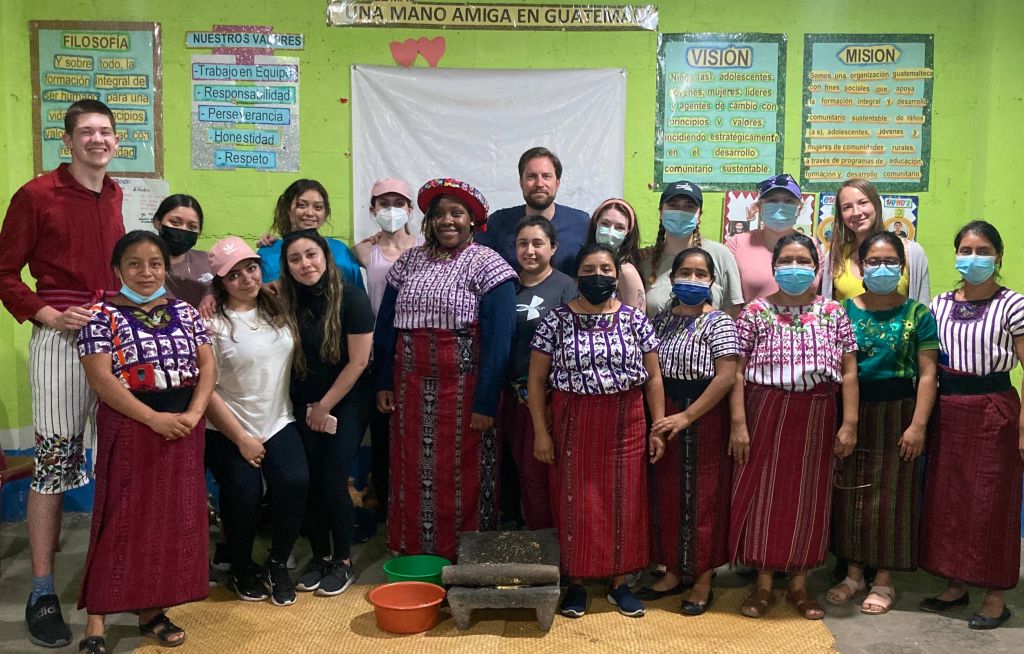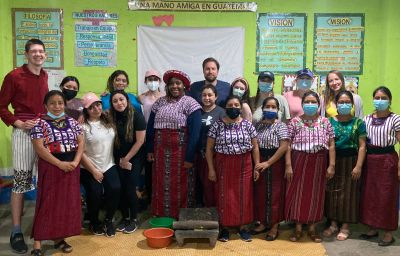Katy Thornthwaite is a music and secondary education double major from Black River, NY.
Our first weekend in Guatemala started bright and early with our van leaving Semilla at 6:00 am. After about an hour and a half in the car, we arrived in Tecpan for breakfast at a local restaurant. Our breakfast options were pancakes, waffles, or a traditional Guatemalan breakfast of eggs, beans, and fried plantains. After filling up on food and coffee, we were on the road again.
Our first stop of the day was at Iximche, Mayan ruins of the Kaqchikel people. Our tour guide, Myra, told us about the history of the city, the families that lived there, and what their life was like. There were four different plazas, one for each family, and each plaza contained temples for the Sun, the Moon, the spiritual leaders, houses for the family, and a ball court. As we walked through each plaza, we were able to see how Mayan spirituality influenced the architecture. For example, the stairs into the ball court were small not because the Kaqchikel people had small feet, but because they walked up the stairs diagonally to pay reverence to the Sun God.

After our time at Iximche, we piled back into the van and drove to Panajachel, a town on the edge of Lake Atitlan. We then climbed into a boat and took at 20 minute boat ride across the lake to Santiago, where we would be staying for the night. We traveled by pick-up truck from the lake to ANADESA, a cooperative of Tz’utujil women that worked to provide education to the local children and a place to sell their beaded products for a fair price. After lunch, we went next door to the Peace Park, which was the site of a massacre on December 2, 1990 of the Tz’utujil people. The park had monuments for each person who was killed and a copy of the edict that banned the Guatemalan Army from entering the town of Santiago, which is still in place today. We then met in one of the classrooms and had the opportunity to learn more about the Tz’utujil culture. We got to see what their kitchen tools looked like in the past versus today and what the main differences are. We also learned how to make tortillas and got to try our hand at removing the corn kernels and using the grinding stone to make the dough. Lastly, we learned about the traditional dress of the men and women of the Tz’utujil. Two of our group members, Nakiyah and Isaac, got to try on the outfits.

After the demonstration, we transitioned to host families for the evenings. We traveled by pick-up truck to a village and met with our host moms. Myself, Mariah, and Orsi stayed with a woman named Ana. Ana mostly spoke Tz’utujil, but she did speak a little Spanish. She fed us a delicious dinner of rice, beans, and fried cauliflower. Her brother, Diego, lived next door and came over to talk to us. We spoke to them about Guatemala, the United States, and our trip so far. Although our Spanish isn’t great, we were able to communicate fairly well using teamwork.
The next morning, Ana fed us a traditional Guatemalan breakfast before we departed to meet up with our group at the Catholic Church in the middle of the town. We then traveled by boat to San Juan, another town on Lake Atitlan. Once in San Juan, we toured different cooperatives to learn about the local products. We toured a bee farm and taste-tested their honey products. Then we had a weaving demonstration and had the chance to purchase their products. Next up was a medicinal plant shop that showed us all of the plants they grew and their different purposes. Lastly, we went to a chocolate shop that showed us the process of chocolate making from growing a cacao tree to the final product, which we got to taste test.

After a morning full of tours and shopping, we made our way back to the boat. After a tumultuous journey across Lake Atitlan, we returned to our van for the journey through the mountains and back to Semilla. Our weekend was filled with many opportunities to experience the Indigenous Mayan culture, both through learning demonstrations and home stays. Up next: learning about migration and human rights in Guatemala.






